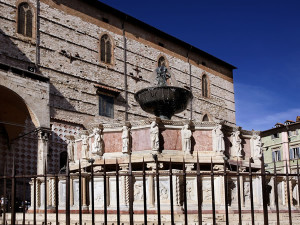The historical town center developes around this location and around the sloping hills which begin from the city, thus forming an acropolis and five Medieval boroughs which continue along five entrance ways. A new and permanent wall long 9 km ( 15 miles ) was added to the earlier Etruscan boundries long 3 km ( 2 miles ) in the twelve and thirteen hundreds and is still intact; it confines a vast area of 120 ectars ( 296 acres ).
The historical boroughs are Porta Sole, Porta Sant’Angelo, Porta S. Susanna, Porta Eburnea and Porta San Pietro each of which have their own territorial boundries that remained unchanged for centuries, from the founding of the city to the formation of a township. Beyond the historical town center, the territory continues to the Massian Plain.
Perugia is located in the hinterland of Central Italy in the widest point of the peninsula.
It is the largest city between Florence and Rome, located in an internediate position: 150 km (93 miles ) from Florence, Rome and Ancona and 400 km (248 miles ) from Milan, Genova and Naples.






